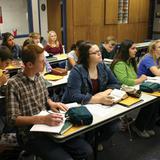The Church of Jesus Christ of Latter-day Saints emphasizes the importance of continued secular and spiritual education. The Church Educational System (CES) is the umbrella for all education programs of the Church. (See Mormons and Education: An Overview, a detailed piece on the Church and education).
| Seminary students 2012 Intellectual Reserve, Inc. All rights reserved. | 1 / 3 |
Universities and Colleges
- Brigham Young University (BYU) in Provo, Utah, offers bachelor’s and graduate degree programs for over 30,000 students.
- BYU-Hawaii in Laie, Hawaii, has an enrollment of approximately 2,400 students. According to a 2006 U.S. News and World Report survey, BYU-Hawaii is the most internationally diverse campus in the United States, with more than 74 countries represented.
- BYU-Idaho, formerly Ricks College, became a four-year university in 2000. Located in Rexburg, Idaho, the school accommodates over 11,000 students. In 2005, Dr. Kim B. Clark, former dean of Harvard Business School, was named the 15th president of BYU-Idaho.
- LDS Business College is located in downtown Salt Lake City, Utah. It offers one- and two-year vocational programs. Approximately 1,300 students attend.
Institutes of Religion
- Institutes of religion provide religious instruction for Church members who are single and between the ages of 18 and 30. Married college students also attend classes. These classes are not only for members of the Church, but are open to those of all faiths.
- Institute students study topics such as scriptures, Church history, doctrine, and preparation for marriage and missions.
- Classes are taught by full-time instructors, as well as volunteers appointed by local leadership.
- Along with religious education, institutes provide an enjoyable social and recreational atmosphere in which students can interact.
Seminary
- Seminary is a four-year educational program for high school students. It is open to teenagers of all faiths.
- Students spend an entire school year studying one book of scripture: Old Testament, New Testament, Book of Mormon or Doctrine and Covenants. By the time a student graduates, he or she will have completed the study of all four books.
- In communities with a large Latter-day Saint population, students attend seminary during “released time” from their normal school day. In other parts of the world, students attend either before school starts or after school. In some cases where distance is an issue or there are not many Latter-day Saint teenagers, students may complete the four-year curriculum in a home study program.
- Classes are taught by both full-time instructors and volunteers.
- There are approximately 350,000 seminary students worldwide.
Perpetual Education Fund
In March 2001, President Gordon B. Hinckley announced the creation of the Perpetual Education Fund to provide members with opportunities to gain education and training which lead to employment opportunities in their own countries. Young men and women who are living in certain areas outside of the United States may apply for the fund. The fund gives loans, with minimal interest, to the student to pay for tuition and books. After the student completes school, he or she will repay the loan over an eight year period. Members of the Church donate money to help the fund continue.




